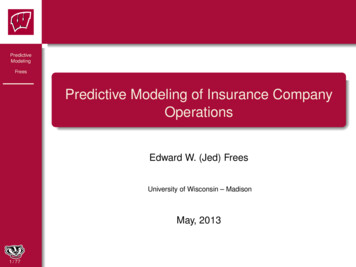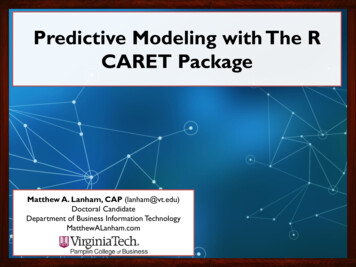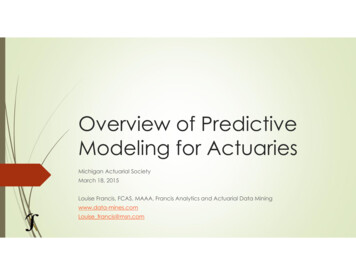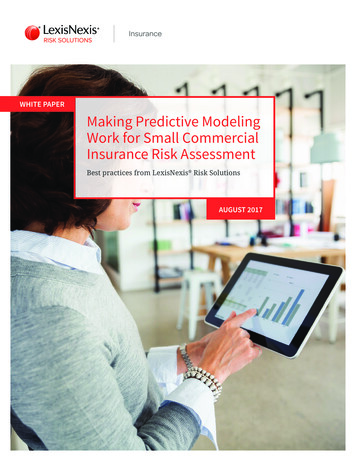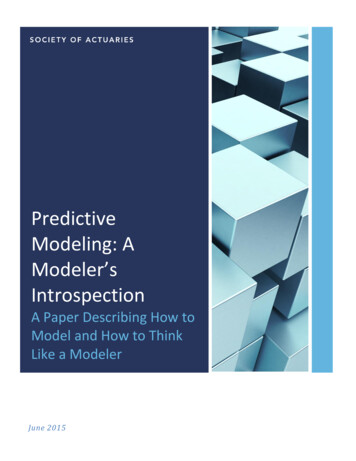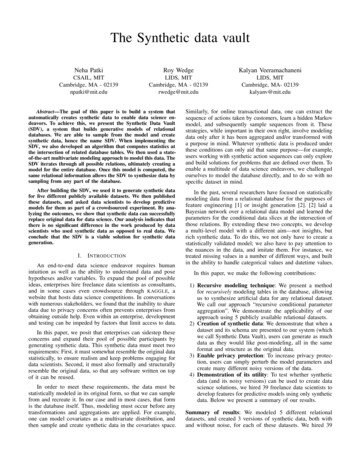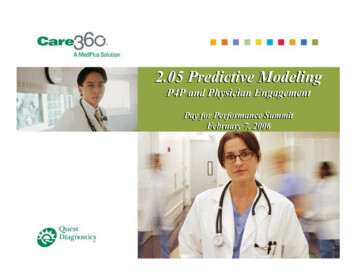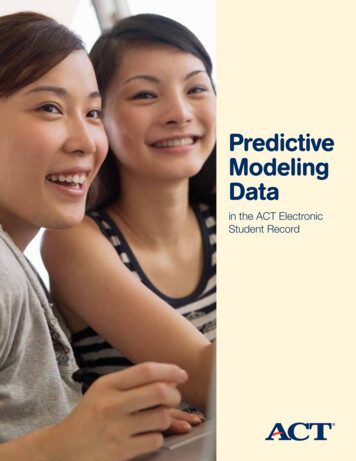
Transcription
PredictiveModelingDatain the ACT ElectronicStudent Record
overviewPredictive Modeling Data Added to the ACT Electronic Student RecordWith the release of student records in September 2012, predictive modelingdata from four behavioral indexes were added to the ACT Electronic StudentRecord. A fifth index, the Interest–Major Fit score, was also added to thestudent record.The predictive modeling data elements do not predict whether a student willenroll at a specific institution; rather, they predict four enrollment behaviors:nThe Mobility Index predicts the likelihood of a student enrolling out ofstate. Mobility Index scores range from a low of 01 to a high of 99. Thehigher the score, the more likely the student will enroll out of state.nThe Institution Type Index predicts the likelihood of a student enrollingat a private college or university. Institution Type Index scores range froma low of 01 to a high of 99. The higher the score, the more likely thestudent will enroll at a private institution.nThe Selectivity Index predicts the selectivity of the institution at which astudent is most likely to enroll. Selectivity Index scores range from 0.0 to5.0, in increments of 0.1. A higher Selectivity Index corresponds to agreater likelihood of attending a more selective institution.nThe Institution Size Index predicts the size of the institution at whichthe student is most likely to enroll. Institution Size Index scores rangefrom 0.0 to 4.0, in increments of 0.1. A higher Institution Size Index scorecorresponds to a greater likelihood of attending a larger institution.Percentile ranks for each index are not reported on the student score report;crosswalk tables showing percentile ranks for all index values will beavailable on the ACT website at www.act.org/aap/infosys/recordinfo.html.2
index locationsPosition Locations of the Indexes in the ACT Electronic Student RecordIn Table 1 below are the positions of the five new indexes in the ACTElectronic Student Record:Table 1. Five new indexes in the ACT Electronic Student RecordFieldPositionRangeMobility Index391–39201–99Institution Type Index393–39401–99Selectivity Index395–39600–50 with an implied decimalInstitution Size Index397–39800–40 with an implied decimalInterest–Major Fit Score399–40000–99All data are numeric. If no predictions are made, the fields are set to blank. The fullrecord layout is available online at curacy of the Predictive Modeling FieldsThe four Predictive Modeling Indexes are built using actual data on enrolled students andare, therefore, very accurate. Every year, ACT sends a file of all ACT-tested students in thatyear’s high school graduating class to the National Student Clearinghouse, which matchesthe ACT file with its institutional enrollment records. More than 3,300 colleges anduniversities, enrolling more than 96% of all students in public and private U.S. institutions,participate in the Clearinghouse. As a result, ACT has information on first-time collegeenrollments for most of the ACT-tested students who go to college. Because ACT has dataon which students go out of state, which students attend private institutions, and theselectivity and size of the institutions that students attend, it is possible to develop predictivemodels that accurately predict those four behaviors.The accuracy of the Predictive Modeling Indexes relates directly to the self-reportedinformation provided by students about their enrollment preferences (type and size ofinstitution and preferred distance from home to campus), as well as the types of institutionsthey are considering. When students take the ACT, they can choose to send their scores toup to six institutions in preference order. ACT calls this mix of campuses (instate/out of state,public/private, selective/non-selective, large/small) the “Choice Set.” Through extensiveresearch, ACT has determined that this Choice Set carries a predictive power that faroutweighs other variables. Because the indexes reflect a student’s Choice Set in measurableand objective ways, they provide quite a bit of information not only on student enrollmentintentions but also on your competition—the other institutions besides yours to which astudent sends scores.3
mobility indexPredicting Out-of-State EnrollmentThe Mobility Index predicts the likelihood that a student will enroll at an out-of-stateinstitution, using (1) the student Choice Set or campus mix (campuses to which studentssend scores); (2) ACT Composite score; (3) preferred distance from home to campus; and(4) selected other variables.The campus mix comprises more than four-fifths of the Mobility Index model; this suggeststhat the student score sender choices are intentional, and thus serve as the basis foraccurate predictions. If students send scores to out-of-state institutions, they are much morelikely to enroll out of state. If students do not send scores to out-of-state institutions, they arevery unlikely to enroll out of state.The score range of the Mobility Index is 01 to 99. The higher the score, the more likely thestudent is to enroll out of state. The lower the score, the more likely the student is to enrollinstate.Table 2 shows the percent of students in the 2011 ACTtested graduating class whose Mobility Index score fallswithin specific ranges. ACT research shows that only about20% of ACT-tested students enroll out of state, so mostMobility Index scores are quite low; 53% of all ACT-testedstudents have Mobility Index scores of 20 or lower. Studentswith Mobility Index scores of 20 or higher are more likelythan average to enroll out of state.Table 2. Percent of 2011 ACT-testedgraduates in each Mobility Indexscore rangeMobility IndexScore RangesPercent in EachRange (National)01–052406–2029Students with very low scores on the Mobility Index arelooking only instate. Students with very high scores areprobably looking only out of state. Students in the middleranges are probably looking both instate and out of ble 3 below shows the percent of students in the 2011ACT-tested graduating class by ACT Composite score and for a given range of Mobility Indexscores. Students with a Composite score below 24 tend to have lower Mobility Index scores.Students with a Composite score of 24 and above tend to have higher Mobility Index scores.Students with ACT Composite scores of 24 and higher are more likely than average to go outof state.Table 3. Percent of 2011 ACT-tested graduates at combinations ofACT Composite score range and Mobility Index score rangeACT Composite Score RangesMobility IndexScore –9902102544194
institution type indexPredicting Enrollment at a Private College or UniversityThe Institution Type Index predicts the likelihood that a student will enroll at a private collegeor university by using (1) the student Choice Set or campus mix (campuses to which astudent sends scores); (2) ACT Composite score; (3) preferred institution type; and(4) selected other variables. The campus mix comprises almost two-thirds of the InstitutionType Index model. Preferred institution type accounts for another quarter of the model.Together, the campus mix and preferred institution type account for almost 90% of themodel; this suggests that the student score sender choices are intentional, and thus serveas the basis for accurate predictions.The score range of the Institution Type Index is 01 to 99. The higher the score, the morelikely the student is to enroll at a private college or university. The lower the score, the morelikely the student is to enroll at a public college or university.Table 4 shows the percent of students in the 2011 ACTtested graduating class whose Institution Type Indexscores fall within specific ranges. ACT research showsthat only about 20% of ACT-tested students enroll atprivate institutions, so most Institution Type Index scoresare quite low; 61% of all ACT-tested students haveInstitution Type Index scores of 20 or lower. Students withInstitution Type Index scores of 20 or higher are morelikely than average to enroll at private institutions.Table 4. Percent of 2011 ACT-testedgraduates in each Institution Type Indexscore rangeInstitution TypeIndex Score RangesPercent in EachRange (National)01–051306–204821–3518Students with very low scores on the Institution TypeIndex are probably looking only at public institutions.Students with very high scores are probably looking onlyat private institutions. Students in the middle ranges areprobably looking at both public and private e 5 below shows the percent of students in the 2011 ACT-tested graduating class byACT Composite score and for a given range of Institution Type Index scores. Students with aComposite score below 24 tend to have lower Institution Type scores. Students with aComposite score of 24 and above tend to have higher Institution Type Index scores.Table 5. Percent of 2011 ACT-tested graduates in combinations ofACT Composite score range and Institution Type Index score rangeACT Composite Score RangesInstitution TypeIndex Score –9903143141115
selectivity indexPredicting Enrollment by Selectivity of InstitutionACT classifies colleges and universities into five categories of admission selectivity: highlyselective, selective, traditional, liberal, and open. The Selectivity Index predicts the selectivityof the institution at which the student is likely to enroll, using (1) the student Choice Set orcampus mix (campuses to which a student sends scores); (2) ACT Composite score; (3) highschool GPA; and (4) selected other variables.The campus mix comprises more than three-fourths of the Selectivity Index model. ACTComposite score accounts for another 14% of the model. Together, the campus mix andACT Composite score account for 93% of the model; this suggests that the student scoresender choices are intentional, and thus serve as the basis for accurate predictions.Students are very likely to send scores to institutions that are similar in selectivity to theinstitution at which they will eventually enroll.The score range of the Selectivity Index is 0.0 to 5.0. The higher the score, the more likelythe student is to attend a more selective college or university. The lower the score, the morelikely the student is to attend a less selective college or university.Table 6 shows the percent of students inthe 2011 ACT-tested graduating classwhose Selectivity Index scores fall withinspecific ranges. Three-fourths of all ofthese students enroll at institutions in theTraditional and Selective categories.Table 6. Percent of 2011 ACT-tested graduatesin each Selectivity Index score rangeSelectivity IndexScore RangesPercent in EachRange 16Liberal2.1–2.835TraditionalInstitutions which are highly selective or2.9–3.840Selectivewhich are open admission will see mostenrolled students distributed at the top3.9–5.07Highly Selectiveor bottom of the Selectivity Index scale.Institutions of medium or traditionalselectivity often find that they enroll significant numbers of students from several selectivitybands. This, again, may reflect a population looking at several types and sizes of institutionsclose to home.Table 7 below shows the percent of students in the 2011 ACT-tested graduating class byACT Composite score and for a given range of Selectivity Index scores. Students with aComposite score below 24 tend to have lower Selectivity Index scores. Students with aComposite score of 24 and above have much higher Selectivity Index scores.Table 7. Percent of 2011 ACT-tested graduates at combinations ofACT Composite score range and Selectivity Index score rangeSelectivity IndexScore RangesSelectivityCategoryACT Composite Score –5.0Highly Selective0011263246
institution size indexPredicting Enrollment by Size of InstitutionFor purposes of the Institution Size Index, ACT classifies colleges and universities into four sizecategories of full-time undergraduate populations: fewer than 5,000, 5,000–9,999, 10,000–19,999, and more than 20,000. The Institution Size Index predicts the size of the institution atwhich the student is likely to enroll, using (1) the student Choice Set or campus mix (campusesto which a student sends scores); (2) ACT Composite score; (3) preferred college size; and(4) selected other variables.The campus mix comprises more than four-fifths of the Institution Size Index model. ACTComposite score accounts for another 7% of the model. Together, the campus mix and ACTComposite score account for more than 95% of the model; this suggests that the studentscore sender choices are intentional, and thus serve as the basis for accurate predictions.Students are very likely to send scores to institutions that are similar in size to the institution atwhich they will eventually enroll.The score range of the Institution Size Index is .01 to 4.0. The higher the score, the more likelythe student is to attend a larger institution. The lower the score, the more likely the student isto attend a smaller institution.Table 8 shows thepercent of students inthe 2011 ACT-testedgraduating class whoseInstitution Size Indexscores fall within specificranges; 64% of studentsenroll at institutions inthe medium and largecategories.Table 8. Percent of 2011 ACT-tested graduatesin each Institution Size Index score rangeInstitution SizeIndex Score RangesPercent in EachRange (National)Institution SizeCategories0–1.620 9,9992.8–4.016 20,000InstitutionSize TypeSmallMediumLargeVery LargeIf your institution is very large or very small, you will see most enrolled students distributed atthe top or bottom of the Institution Size Index score ranges. If your institution is medium size,you may find that you enroll significant numbers of students from several size bands. This,again, may reflect a population looking at several types and sizes of institutions close to home.Table 9 below shows the percent of students in the 2011 ACT-tested graduating class byACT Composite score and for a given range of Institution Size Index scores. Students witha Composite score below 20 tend to have lower Institution Size Index scores. Students with aComposite Score of 24 and above have much higher Size Index scores. Students with aComposite score of 20–23 are evenly distributed across all size categories.Table 9. Percent of 2011 ACT-tested graduates at combinations ofACT Composite score range and Institution Size Index score rangeACT Composite Score RangesInstitution SizeIndex Score RangesInstitution –360–1.6 –2.710,000–19,99921329312142.8–4.0 20,0001521353267
relationshipsThe Relationship of ACT Composite Score,Distance from Home to Campus, and the IndexesACT research suggests that academic ability is the primary determiner of enrollmentbehavior. As ability levels rise, students are more likely to enroll out of state, more likely toenroll at a private college or university, more likely to enroll at a selective institution, and morelikely to enroll at a larger institution.Table 10 below shows the median miles from home to campus for enrolled students in the2011 ACT-tested graduating class by selectivity. Miles are provided at the 25th percentile, themedian, and the 75th percentile.Table 10. Miles from home to campus for 2011 ACT-tested graduates by admission policyAdmission PolicyCount25th PercentileMedian75th PercentileHighly 3415.671.9183.5Because the indexes are determined so much by the Choice Set, it is important to considerhow the Choice Set is influenced by ACT Composite score as well as distance from home tocampus.For many students, the primary enrollment intention is to enroll close to home. In fact, abouthalf of all ACT-tested students enroll within 50 miles of home. When considering collegesclose to home, it is not uncommon for a student to consider a wide variety of institutions:2-year/4-year, public/private, and institutions of varying size and selectivity.In contrast, students planning to enroll farther from home or out of state tend to send scoresto institutions that match their specific enrollment intentions. For example, a student mightlook at several selective private institutions out of state or several large public institutionsout of state. On the other hand, it would be very unusual for a student to send scoresout-of-state to a 2-year school and a 4-year school or to a selective public school and anon-selective public school.8
data sheetsPredictive Modeling Institution Data SheetsTo use the index data strategically, institutions will want to know howpredictive the indexes are for enrolled students at their institution. For mostinstitutions in the country, ACT is able to prepare a Predictive ModelingInstitution Data Sheet that shows an institution’s 2011 ACT-tested enrolledstudents in terms of the four indexes.To request a Predictive Modeling Institution Data Sheet for your institution,contact EMS@act.org or your ACT regional representative.Here are a few general rules for interpreting the data sheets:If the enrolled percentages at your institution match closely with the nationaldistributions for each index, this likely means that your institution is lessselective and that most of your enrollment comes from students who livefairly close to your campus. The takeaway in this case is that many studentsmay be choosing your institution because of where your institution is locatedrather than because of what your institution is (2-year/4-year, public/private,selective/non-selective, large/small). Students may be choosing yourinstitution because it is close to where they live, and one of their primaryenrollment intentions may be to enroll close to home.In contrast, more selective institutions will usually show enrolled studentdistributions quite different from the national distributions because they areenrolling more students from a greater distance and those who are lookingfor a specific size, type, and selectivity of institution.9
strategic useUsing the Index Data StrategicallyStudent score reports sent to colleges and universities contain more than 265 data fieldsthat can be used for two strategic purposes: (1) assessing a student’s postsecondaryenrollment intentions; and (2) assessing a student’s level of interest in your institution.Information about student enrollment intentions comes from the four indexes, studentenrollment preferences for size and type of institution and preferred distance from home tocampus, and other variables such as highest degree expected.Information about a student’s level of interest in your institution comes from level of collegechoice (or where they send their scores) and how closely their interests, needs, andpreferences match your institution.Information in the score report on student interests, plans, and needs can be used topersonalize communications. Like other data in the ACT score report, the four PredictiveModeling Indexes provide you with data which can be used to better target, segment, andcommunicate with students.The indexes represent point-in-time enrollment intentions, and they should always be viewedas starting points. Any subsequent interactions that an institution has with a student willincrease or decrease that student’s likelihood of enrolling. However, as a starting point, theinformation from the indexes can be used to determine how well a student’s enrollmentintentions match the characteristics of your institution.A convenient way to think about segmenting is to assign every score sender to one of fourquadrants, as shown in Figure 1 below. The vertical axis represents how desirable a studentis to your institution; the horizontal axis represents how well the student’s enrollmentintentions (as measured by the indexes and level of college choice) match your institution.Your institution will have target populations that are very desirable and a good match (upperleft quadrant). On the other hand, your institution may have target populations that are verydesirable but not a good match—at least when using the indexes as a starting point todescribe student enrollment intentions—and these fall in the lower left quadrant. In thatexample, you can use the index scores to understand student enrollment intentions and thenbuild strategies to move students toward a better understanding of what your institutionoffers. Other students may fall in the quadrant of low desirability and poor match, and youmay choose to spend less time and fewer resources recruiting those students.Figure 1. Quadrants of student desirabilityas matched to academic intentionsMore DesirableGood MatchLess DesirableGood MatchMore DesirablePoor MatchLess DesirablePoor Match10
predictive modeling and EOSThe Predictive Modeling Indexes and Student Search through ACT EOSFor the past three years, data from the four Predictive Modeling Indexes isincluded with every ACT Educational Opportunity Service (EOS) record thatis downloaded. EOS clients cannot use the indexes as search variables inACT EOS, but each index is closely related to a data variable that can beused when ordering. For example, ACT research shows that students whosay that want to enroll within 25 miles of home have very low Mobility Indexscores. As a result, ACT recommends that institutions do not select thenames of students in ACT EOS who want to enroll within 25 miles of homewhen selecting the names of out-of-state students who live more than100 miles from the campus. Other strategies for using the index datastrategically in ACT EOS are summarized in “Using EOS Search CriteriaRelated to Predictive Modeling Indexes.pdf,” available online atwww.act.org/eos/order.html.Table 11 below shows the positions of the four indexes (and the associatedpercentile ranks) in the ACT EOS Electronic Student Record:Table 11. Positions of Predictive Modeling Indexesin the ACT EOS Electronic Student RecordFieldPosition/FormatRangeMobility Index272–275 (x.xx)0.01–0.99Percentile Rank Mobility Index277–278 (xx)Institution Type Index280–283 (x.xx)Percentile Rank Institution Type Index285–286 (xx)Selectivity Index288–290 (x.x)Percentile Rank Selectivity Index292–293 (xx)Institution Size Index295–297 (x.x)Percentile Rank Institution Size Index299–300 (xx)110.01–0.990.0–5.0.00–4.0
fit scoresInterest–Major Fit ScoreEffective with the release of student records in September 2012, an Interest–Major Fit score was added to the ACT electronic record. Interest-major fit isderived from two data elements that are collected during ACT registration:(1) the student’s ACT Interest Inventory scores; and (2) the student’s intendedmajor chosen from a list of 294 college majors.The Interest–Major Fit score measures the strength of the relationshipbetween the student’s ACT Interest Inventory scores and the profile ofinterests of students in a given major. Interest-Major Fit scores range froma low of 01 to a high of 99. The higher the score, the better the interest–major fit.Research at ACT and elsewhere suggests that if students’ measuredinterests are similar to the interests of people in their chosen college majors,they will be more likely to:npersist in collegenremain in their majorncomplete their college degree in a timely mannerInterest–major fit clearly benefits both students and the college they attend:students engaged in good-fit majors are more likely to stay in college, stay intheir major, and finish sooner.Interest profiles for majors are based on a national sample of undergraduatestudents with a declared major and a GPA of at least 2.0. Major wasdetermined in the third year for students in 4-year colleges, and in thesecond year for students in 2-year colleges.12
strategic useRecruitment Strategies for Using the Interest–Major Fit ScoreMany institutions build mail, e-mail, and telephone outreach strategies tied tostudent intended major. For example, these strategies may include mailing ore-mailing information about academic departments and colleges, or, in somecases, having professors or students contact prospective student majors byphone. All such outreach strategies cost time and money. By combiningdata from a student’s intended major with an Interest–Major Fit score,campuses can identify students who may have a stronger interest in aparticular major and who may be more likely to enroll in a particular major. Asa result, campuses could do more targeted outreach using both intendedacademic major and interest–major fit and, perhaps, save time, money, andresources.Advising and Retention Strategies forUsing the Interest–Major Fit ScoreCollege retention interventions often include efforts toidentify students more likely to drop out or not makeadequate progress toward a degree. Because ACTresearch suggests that good interest–major fit can lead topositive retention and persistence outcomes, it followsthat advisors and retention professionals can use poorInterest-Major Fit scores as a part of efforts to identifyat-risk students or students who could benefit fromadvising and career planning interventions. 2012 by ACT, Inc. All rights reserved. The ACT is a registeredtrademark of ACT, Inc., in the U.S.A. and other countries.1896113
The predictive modeling data elements do not predict whether a student will enroll at a specific institution; rather, they predict four enrollment behaviors: n The Mobility Index predicts the likelih

